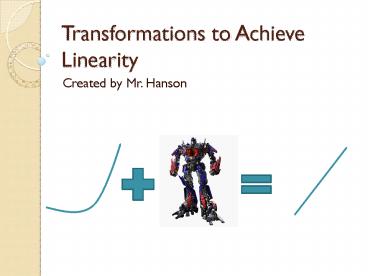Transformations to Achieve Linearity - PowerPoint PPT Presentation
1 / 21
Title:
Transformations to Achieve Linearity
Description:
Transformations to Achieve Linearity Created by Mr. Hanson Objectives Course Level Expectations CLE 3136.2.3 Explore bivariate data Check for Understanding (Formative ... – PowerPoint PPT presentation
Number of Views:69
Avg rating:3.0/5.0
Title: Transformations to Achieve Linearity
1
Transformations to Achieve Linearity
- Created by Mr. Hanson
2
Objectives
- Course Level Expectations
- CLE 3136.2.3 Explore bivariate data
- Check for Understanding (Formative/Summative
Assessment) - 3136.2.7 Identify trends in bivariate data find
functions that model the data and that transform
the data so that they can be modeled.
3
Common Models for Curved Data
- Exponential Model
- y a bx
- Power Model
- y a xb
The variable is in the exponent.
The variable is the base and b is its power.
4
Linearizing Exponential Data
- Accomplished by taking ln(y)
- To illustrate, we can take the logarithm of both
sides of the model. - y a bx
- ln(y) ln (a bx)
- ln(y) ln(a) ln(bx)
- ln(y) ln(a) ln(b)x
Need Help? Click here.
A BX
This is a linear model because ln(a) and ln(b)
are constants
5
Linearizing the Power Model
- Accomplished by taking the logarithm of both x
and y. - Again, we can take the logarithm of both sides of
the model. - y a xb
- ln(y) ln (a xb)
- ln(y) ln(a) ln(xb)
- ln(y) ln(a) b ln(x)
- Note that this time the logarithm remains
attached to both y AND x.
A BX
6
Why Should We Linearize Data?
- Much of bivariate data analysis is built on
linear models. By linearizing non-linear data,
we can assess the fit of non-linear models using
linear tactics. - In other words, we dont have to invent new
procedures for non-linear data.
HOORAY!!
7
Procedures for testing models
8
Example Starbucks Growth
- This table represents the number of Starbucks
from 1984-2004. - Put the data in your calculator
- Year in L1
- Stores in L2
- Construct scatter plot.
Forgotten how to make scatterplots? Click here.
9
Note that the data appear to be non-linear.
10
Transformation time
- Transform the data
- Let L3 ln (L1)
- Let L4 ln (L2)
- Redraw scatterplot
- Determine new LSRL
Forgotten how to determine the LSRL? Click here.
11
Original
12
Exponential (x, ln y)
13
Original
14
Power (ln x, ln y)
15
Remember Inspect Residual Plots!!
Exponential
Power
NOTE Since both residual plots show curved
patterns, neither model is completely
appropriate, but both are improvements over the
basic linear model.
Forgotten how to make residual plots? Click here.
16
R-squared (A.K.A. Tiebreaker)
- If plots are similar, the decision should be
based on the value of r-squared. - Power has the highest value (r2 .94), so it is
the most appropriate model for this data (given
your choices of models in this course).
Forgotten how to find r-squared? Click here.
17
Writing equation for model
- Once a model has been chosen, the LSRL must be
converted to the non-linear model. - This is done using inverses.
- In practice, you would only need to convert the
best fit model.
18
Conversion to Exponential
- LSRL for transformed data (x, ln y)
- ln y -20.7 .2707x
- eln y e-20.7 .2707x
- eln y e-20.7 (e.2707x)
- y e-20.7 (e.2707)x
Transformed Linear Model a bx
Exponential Model a bx
19
Conversion to Power
- LSRL for transformed data (ln x, ln y)
- ln y -102.4 23.6 ln x
- eln y e-102.4 23.6 ln x
- eln y e-102.4 (e23.6 ln x)
- y e-102.4 x23.6
Transformed Linear Model a bx
Exponential Model a bx
20
View non-linear model with non-linear data
21
Assignment
- U.S. Population Handout
- Rubric for assignment
Need Help? Email me at hansonb_at_rcschools.net































